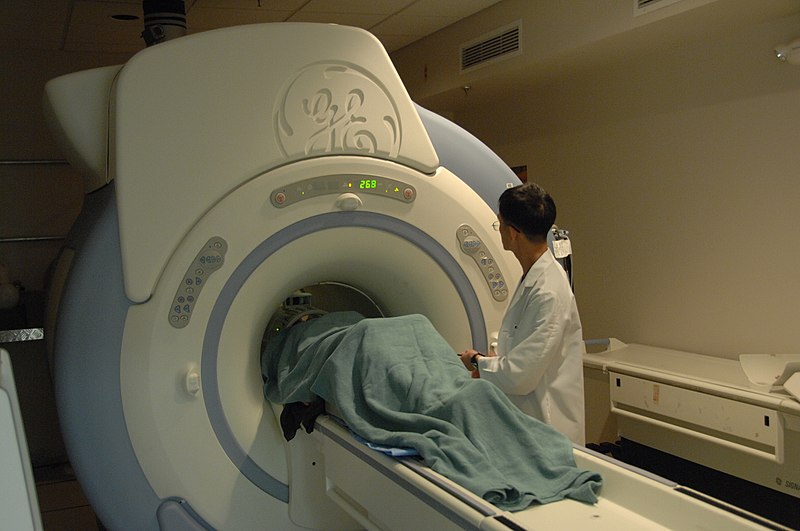Concussion Criminality: Many ‘Criminals’ Suffer from Brain Injuries
Ignoring the mind behind the crime
NIH IMAGE GALLERY VIA WIKIMEDIA COMMONS
Current technology like fMRI can detect traumatic brain injury in patients and help them get started with treatment to avoid worsening symptoms that may lead to criminal behavior.
March 18, 2021
Jails and prisons have disproportionately incarcerated the brain-injured population for decades in the U.S. The alarming correlation between traumatic brain injury (TBI) and incarceration rates cannot be overlooked in the analysis of the criminal justice system’s troubles.
The Centers for Disease Control and Prevention (CDC) defines TBI as a “disruption in the normal function of the brain that can be caused by a bump, blow, or jolt to the head, or penetrating head injury.” Brain injury leads to a host of problems, including an increased risk of psychiatric disorders, aggressive behaviors and substance abuse. Abusive experiences tend to increase the inclination towards violence after incurred injury.
The link between TBI and the prison system was initially identified and published at the 1998 National Institutes of Health conference through the individual regressive behavior and functionality. Chronic traumatic encephalopathy and other types of TBI include problems associated with poor impulse control, impaired judgment and aggression. Another variable is the age at which the injury is acquired. For youths, brain injury tends to lead them down a more aggressive path as they age.
The Hunger of the Justice System
“It’s about brain damage that cannot be repaired that easily — it is not just a matter of a person’s willpower.” Denise Galloway, TBI service coordinator
Denise Galloway is a TBI service coordinator, a specialized social worker who manages benefits and assists in directing programs for survivors of brain injuries. In an interview, she said that the justice system wants its “pound of flesh.”
“As recently as 1999, TBI was hidden under the diagnoses of mental illness,” according to Galloway. Mental illness is, however, a secondary condition to the primary physical injury. “TBI — it’s like French, a totally different language,” Galloway commented. Brain injury has its stereotypes but is fundamentally misunderstood.
Damage to areas of the frontal lobe results in loss of inhibition and self-regulation. Impulse control, lack of interpersonal sensitivity and reactive aggression are the resultant characteristics. “Oh, it’s behavior. That’s the line people use a lot, but there is much more to it,” Galloway said. “It’s about brain damage that cannot be repaired that easily — it is not just a matter of a person’s willpower.”
Minimizing the seriousness of brain injury is relatively common, but science dictates the natural human bias to avoid aggression becomes disinhibited, leading to inappropriate responses and behavior.
Brain Injury and Rage
Florida resident and mother of a TBI survivor Jean Naso understood brain injury as “breaking bad.” “TBI is basically survival; (those with brain injuries will) do anything at this point because they don’t realize the consequences of their actions,” Naso said.
Naso’s son, John, incurred a mild traumatic brain injury at the age of 17. She said that his personality transformation petrified her. She saw a “rage on his face (at which point) he would blackout,” using “whatever he could get his hands on” for ill-will. She felt John’s lack of trust, even toward his family members, demonstrated a “sinister side.”
Naso disagrees with “punishing the sick” and is calling for clinical assistance in the courts. “Outside organizations consisting of medical professionals who understand the brain are needed,” she said.
Following the Research
The current problem of criminal justice and TBI lies in the lack of understanding, “lumping” mental illness in with TBI.
Prison administrators find it less costly to ignore TBI diagnoses and any further treatment. Neuropsychologist Kim Gorgens discussed this problem in her 2019 TEDx Talk. She found that 50-80% of the U.S. incarcerated population has incurred TBI due to car accidents, violence or other such matters. In contrast, less than 5% of the general public have acquired brain injury.
Other studies, such as that by the Brain Injury Alliance of Colorado, found that 54% of people in Denver’s prisons between 2013 and 2018 suffered from TBI. The 2013 University of Denver study found that 96% of high-risk populations in prison have TBI. Their research led to a $1 million federal grant for continued research over an additional four years. Ten additional states have secured similar funding and are in coordination with Colorado in TBI research.
Galloway believes the current problem of criminal justice and TBI lies in the lack of understanding, “lumping” mental illness in with TBI. The courts forced John Naso into the Mental Health Courts, where his case was eventually reinstated to the state Supreme Court. Galloway knew of Naso’s case and noted her loss of two clients to the prison system. The two included a TBI survivor with aphasia (the lack of ability to communicate with sufficient verbiage) and another without the necessary support and defense resources. “They may be forever lost,” Galloway said.
Modern Medical Miracles
Today, functional magnetic resonance imaging (fMRI) helps identify an impaired or damaged brain. fMRI can measure blood flow changes in the brain to detect damaged areas handling critical functioning. Discovering and acknowledging TBI is only one step toward stopping criminality.
Professionals like Galloway believe assessment of young people with an acquired brain injury can help avoid regressive development that leads to crime. The natural “coding in the brain, the whole hardwiring, does not exist anymore,” Galloway said. The survivor must learn new pathways to manage day-to-day activities, thought processes and emotions.
Comprehensive neurorehabilitation programs with monitoring are crucial. Some young people may not be adequately served in community-oriented programs and may require a more secure setting.
How We Can Do Better
Treatment is a multifaceted endeavor, including addressing psychiatric illness as a consequence of the injury, understanding the unique progression recovery and evaluating risk factors.
Galloway stressed the need for transition services for those seeking public living and to accommodate those with existing TBI problems. Community reintegration is a primary concern, especially with nearly 95% of the incarcerated population eventually released. Galloway expressed her dismay for the lack of resources, overburden caseloads and the neglect of brain injury especially in discussions of criminality. “Reentry is vital, but we’re all fed up, and we’re all disgusted, but that’s not morally correct,” Galloway said. “We can do better.”
Case-by-case management is necessary because not all injuries are the same. Treatment is a multifaceted endeavor, including addressing psychiatric illness as a consequence of the injury, understanding the unique progression recovery and evaluating risk factors.
These are the necessary steps that can change the course of a TBI survivor’s life so that they may not fall between the cracks and become lost to the system. Treating TBI as an aspect of crime paves the way for medical incentives, further research and perhaps a better lens for the criminal justice system to deter crime.
















